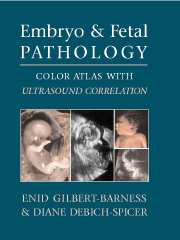Book contents
- Frontmatter
- Contents
- Foreword by John M. Opitz
- Preface
- Acknowledgments
- 1 The Human Embryo and Embryonic Growth Disorganization
- 2 Late Fetal Death, Stillbirth, and Neonatal Death
- 3 Fetal Autopsy
- 4 Ultrasound of Embryo and Fetus: General Principles
- 5 Abnormalities of Placenta
- 6 Chromosomal Abnormalities in the Embryo and Fetus
- 7 Terminology of Errors of Morphogenesis
- 8 Malformation Syndromes
- 9 Dysplasias
- 10 Disruptions and Amnion Rupture Sequence
- 11 Intrauterine Growth Retardation
- 12 Fetal Hydrops and Cystic Hygroma
- 13 Central Nervous System Defects
- 14 Craniofacial Defects
- 15 Skeletal Abnormalities
- 16 Cardiovascular System Defects
- 17 Respiratory System
- 18 Gastrointestinal Tract and Liver
- 19 Genito-Urinary System
- 20 Congenital Tumors
- 21 Fetal and Neonatal Skin Disorders
- 22 Intrauterine Infection
- 23 Multiple Gestations and Conjoined Twins
- 24 Metabolic Diseases
- Appendices
- Index
1 - The Human Embryo and Embryonic Growth Disorganization
Published online by Cambridge University Press: 23 February 2010
- Frontmatter
- Contents
- Foreword by John M. Opitz
- Preface
- Acknowledgments
- 1 The Human Embryo and Embryonic Growth Disorganization
- 2 Late Fetal Death, Stillbirth, and Neonatal Death
- 3 Fetal Autopsy
- 4 Ultrasound of Embryo and Fetus: General Principles
- 5 Abnormalities of Placenta
- 6 Chromosomal Abnormalities in the Embryo and Fetus
- 7 Terminology of Errors of Morphogenesis
- 8 Malformation Syndromes
- 9 Dysplasias
- 10 Disruptions and Amnion Rupture Sequence
- 11 Intrauterine Growth Retardation
- 12 Fetal Hydrops and Cystic Hygroma
- 13 Central Nervous System Defects
- 14 Craniofacial Defects
- 15 Skeletal Abnormalities
- 16 Cardiovascular System Defects
- 17 Respiratory System
- 18 Gastrointestinal Tract and Liver
- 19 Genito-Urinary System
- 20 Congenital Tumors
- 21 Fetal and Neonatal Skin Disorders
- 22 Intrauterine Infection
- 23 Multiple Gestations and Conjoined Twins
- 24 Metabolic Diseases
- Appendices
- Index
Summary
STAGES OF EMBRYONIC DEVELOPMENT
Carnegie staging in the development of the human embryo categorizes 23 stages.
Fertilization and Implantation (Stages 1-3)
Embryonic development commences with fertilization between a spermand a secondary oocyte (Tables 1.1 to 1.5). The fertilization process requires about 24 hours and results in the formation of a zygote – a diploid cell with 46 chromosomes containing genetic material from both parents. This takes place in the ampulla of the uterine tube.
The embryo's sex is determined at fertilization. An X chromosome-bearing spermproduces an XX zygote, which normally develops into a female, whereas fertilization by a Y chromosome-bearing spermproduces an XY zygote, which normally develops into a male.
The zygote passes down the uterine tube and undergoes rapid mitotic cell divisions, termed cleavage. These divisions result in smaller cells – the blastomeres. Three days later, after the developing embryo enters the uterine cavity, compaction occurs, resulting in a solid sphere of 12-16 cells to form the morula.
At 4 days, hollow spaces appear inside the compact morula and fluid soon passes into these cavities, allowing one large space to formand thus converting the morula into the blastocyst (blastocyst hatching). The blastocyst cavity separates the cells into an outer cell layer, the trophoblast, which gives rise to the placenta, and a group of centrally located cells, the inner cell mass, which gives rise to both embryo and extraembryonic tissue.
The zona pellucida hatches on day 5 and the blastocyst attaches to the endometrial epithelium.
- Type
- Chapter
- Information
- Embryo and Fetal PathologyColor Atlas with Ultrasound Correlation, pp. 1 - 22Publisher: Cambridge University PressPrint publication year: 2004
- 1
- Cited by



